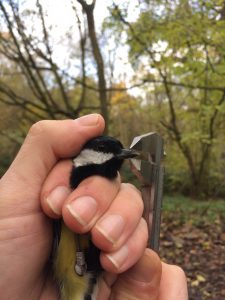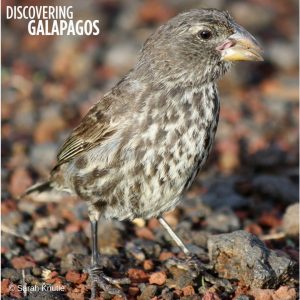From the isolated island of Daphne Major in Galapagos to semi-ancient woodlands in Oxfordshire in the UK, an advance in scientific techniques has enabled us to increase our understanding of evolution on a scale Darwin could not have envisaged.
In the heart of Oxfordshire seventy years ago, a pioneering long-term study of the great tits (Parus major) of Wytham Woods was set up by scientists of the University of Oxford to learn about population change over time. Along with fellow scientists in Oosterhout and Veluwe in the Netherlands, ground-breaking results of evolution in action were uncovered.

- Researcher Keith McMahon measuring a great tits beak in Wytham Woods © Sam Crofts
Over a short period of time, in terms of evolution, the scientists discovered that since the 1970’s the beak length of the great tits of Wytham Woods has increased. According to Professor Jon Slate of the Department of Animal and Plant Sciences at the University of Sheffield, “We now know that this increase in beak length, and the difference in beak length between birds in Britain and mainland Europe, is down to genes that have evolved by natural selection.”
To determine the reason for this change, scientists analysed the DNA of over 3000 birds of both populations to identify genetic differences. Interestingly, the gene sequences that have developed in the British population show similarities with genes related to beak shape in Darwin’s finches.
Researchers believe that our love of feeding garden birds and use of bird feeders in the UK is responsible for the evolution of great tit beaks. They also found those birds with genetic variants for longer beaks frequented bird feeders more often than those without. Continued studies of birds with the longer-beaked variant has shown increased success in reproductive rates in the UK compared to the Netherlands, further supporting evidence of natural selection in the UK population.
The value of historical and genetic data in long-term studies takes us back across the ocean to the island of Daphne Major. For 40 years, British-born couple Peter and Rosemary Grant have focused their research on the island’s population of medium ground finches. Its isolation, lack of human interference, and small number of predators and competitors make it an ideal study location. Being subject to periods of extreme drought and heavy rains associated with ENSO (El Niño Southern Oscillation), the Grants hoped to observe the finches’ response and survival rate to their changing environment and availability of food, so observing natural selection in ‘real time.’

- Medium ground finch in Galapagos is one of the first species observed evolving in real-time ©Sarah Knutie
Between 1973 and 2012, they tagged and tracked at least 20,000 birds, observing and recording their lives and life processes, gathering significant genetic data in the process. In 1977, a severe and devastating drought hit the Islands. No rain fell for 18 months. Many plants withered and died from lack of water. With smaller seeds soon becoming scarce, smaller-beaked birds were unable to feed, and starved. Over 80% of the population died. Having an advantage over the smaller-beaked finches, conditions favoured those with larger beaks as they could successfully crack open the large, tough seeds to feed.
Returning the following year to observe the effect of the drought on the next generation of finches, the Grants found that beak size of the survivors’ offspring had increased. Moving on five years conditions changed again, with Galapagos receiving ten times more rain than normal. Plants that produce small seeds flourished and the birds best adapted to feed on smaller seeds with smaller beaks survived to produce more offspring. Within a few generations, the average size of beaks had decreased. This time, evolution had favoured smaller beaked birds. The Grants had made an historic breakthrough in evolutionary science. They had not only observed evolution on a time scale previously unimaginable, but they had also observed how natural selection itself can be variable.
This was the beginning of many ground-breaking evolutionary discoveries they made during their time on Daphne Major. Their research continues; with advances in genetic techniques and the ability to sample whole genomes, genes responsible for changes in species can be identified and analysed. These developments will enable scientists to answer questions about our own neighbourhood birds, and to determine how human activity is contributory factor in terms of population change.
Teach your class about the adaptations of Darwin’s finches with our teaching resources here.
Information sources:
http://www.ox.ac.uk/news/2017-10-20-british-birds-adapt-their-beaks-birdfeeders
https://www.mhs.ox.ac.uk/naturalhistories/Ecology.html
http://www.pbs.org/wgbh/evolution/library/01/6/l_016_01.html
https://www.wired.com/2016/10/legendary-biologists-clocked-evolutions-astonishing-speed/
https://ncse.com/files/pub/evolution/excerpt–evolution.pdf



 (No Ratings Yet)
(No Ratings Yet)